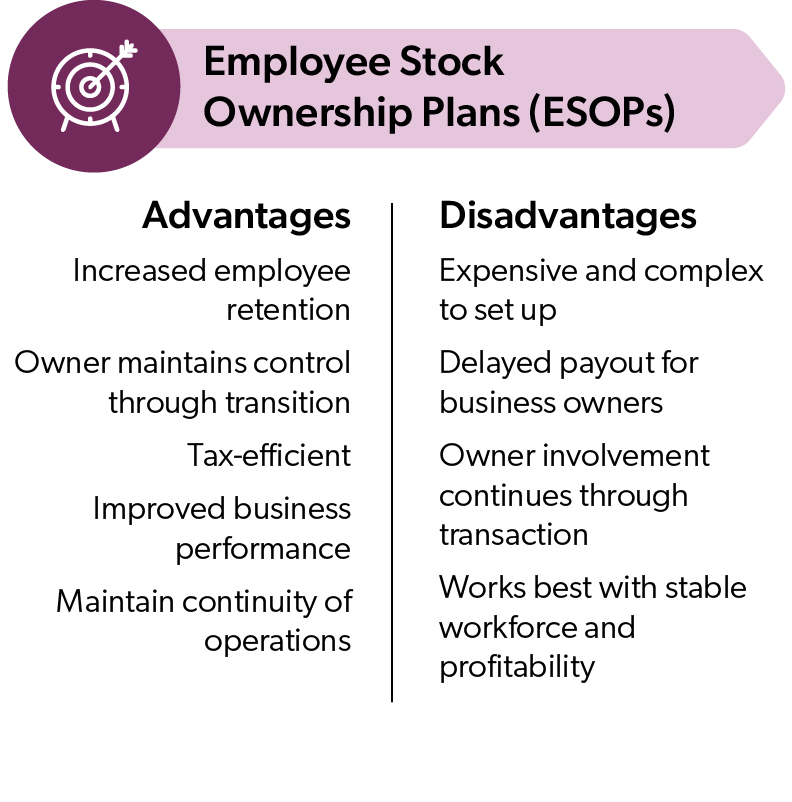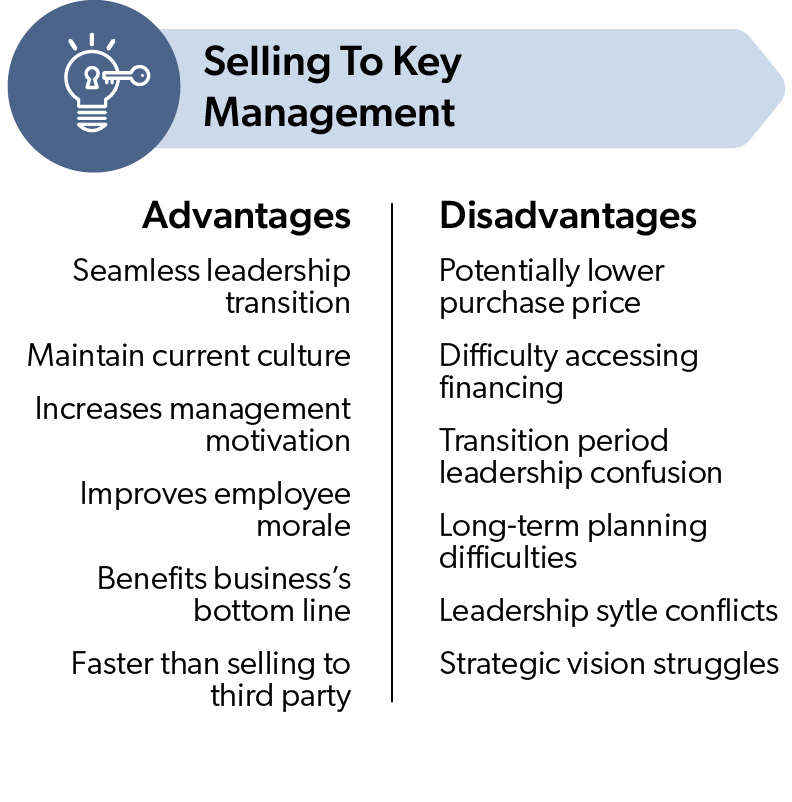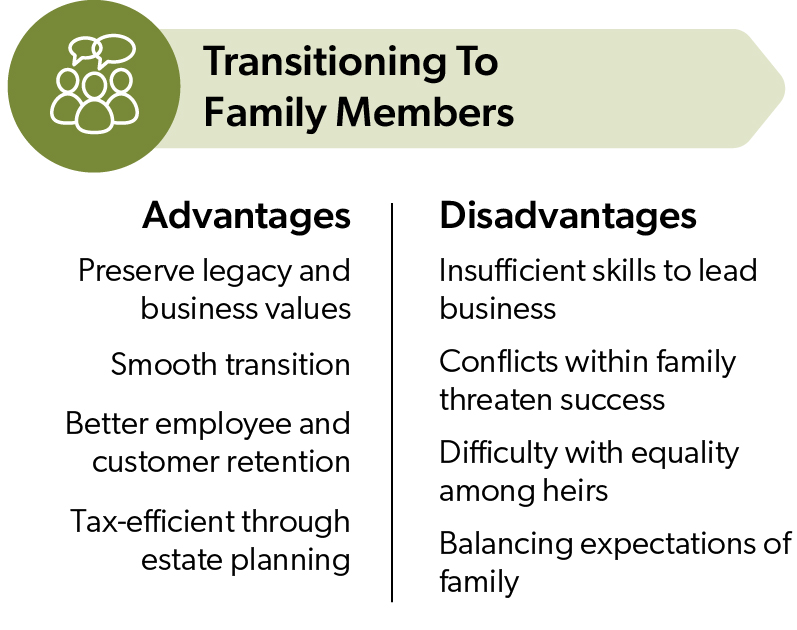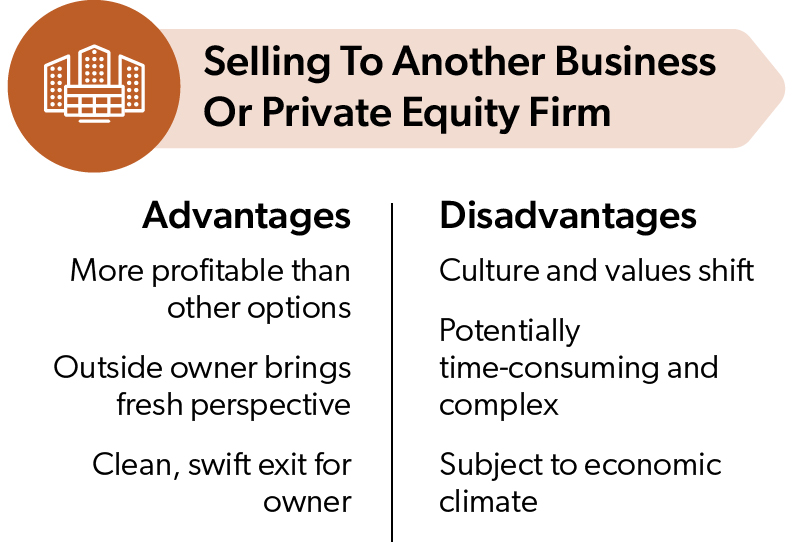Business succession planning is a critical aspect of ensuring the long-term sustainability and prosperity of your business. While it might be difficult and emotional to plan for the day you hand over the keys to your business, business succession planning also helps to preserve your personal wealth, your employees’ livelihoods, and your company’s relationships with its customers.
When planning to transition a business, key leaders, family members, and outside experts can help business owners analyze various strategies to ensure you’re selecting the right path for the stakeholders involved.
In this article, Amy Schneider, CFP®, CWS®, Vice President – Wealth Advisor, contributes insight from her in-depth experience working alongside business owners to help them protect and grow their wealth as they exit their businesses. We’ll discuss common business succession options, like Employee Stock Ownership Plans (ESOPs), selling to key management, transitioning to family, third-party sale, and selling to a private equity firm. Each has advantages and disadvantages, so it’s important to consider all sides of the options to make an informed choice that aligns with your specific goals and circumstances.
ESOPs: Empowering Employees For Business Succession
Employee Stock Ownership Plans (ESOP) involve selling a portion or the entirety of the business to employees. ESOPs can be a way to reward loyal employees and provide them with a stake in the company’s success.
 In an ESOP, a company establishes a trust fund, which is funded by the business. The trust then purchases company shares, effectively making the employees partial owners.
In an ESOP, a company establishes a trust fund, which is funded by the business. The trust then purchases company shares, effectively making the employees partial owners.
“ESOPs can be a win-win, aligning employee interests with company success, but they require careful planning and can be administratively burdensome,” Schneider says. “For business owners looking to transition gradually while preserving company culture, ESOPs offer a structured approach, but they may not deliver immediate liquidity.”
Advantages of ESOPs
ESOPs can have several advantages for employees and business owners. For example, the ESOP serves as a retirement benefit for employees, which increases a sense of loyalty and motivation among employees. Also, it can provide business owners with an exit strategy, allowing them to sell the business while still maintaining a level of control during the transition. Additionally, ESOPs can be a tax-efficient option, as both the contributions to the trust and the proceeds from the sale of shares can be tax-deductible. Another important benefit of ESOPs is that they often lead to improved company performance, as employees are more invested in the company’s success.
Disadvantages of ESOPs
One common drawback of ESOPs is the level of complexity and cost involved in setting up and administering the plan, which can include legal and administrative fees and outside expert guidance. Business owners should know they might not receive the full market value for their business immediately, as a sale to an ESOP typically occurs over time — often anywhere from six to 10 months. Also, they may need to stay involved in the company for a transitional period, which might not align with their exit plan. Lastly, not all businesses are suitable for an ESOP, as it works best in companies with a stable and engaged workforce and a track record of profitability. Ultimately, while ESOPs can be a viable succession option, business owners should carefully assess their goals, the company’s financial health, and the interest and willingness of employees before pursuing forming an ESOP.
Selling A Business to Key Management Team
Selling a business to key management members is a succession strategy that relies on the familiarity, dedication, and expertise of leaders and future leaders within your company. This approach typically involves the transfer of ownership and leadership responsibilities to managers or executives who have demonstrated their commitment to the company’s success.
 “Selling to key management builds a sense of ownership and accountability among your trusted team members, driving them to enhance the legacy you’ve built,” Schneider said. “It ensures a smooth handover while maintaining the momentum of your business’s growth trajectory.”
“Selling to key management builds a sense of ownership and accountability among your trusted team members, driving them to enhance the legacy you’ve built,” Schneider said. “It ensures a smooth handover while maintaining the momentum of your business’s growth trajectory.”
Here are a few steps of how selling your business to key managers works in some companies.
- Identifying Suitable Candidates: Business owners considering this option first identify potential successors within the management team who they think have the skills and vision needed to lead the company effectively. These individuals often have shown loyalty, competence, and a deep understanding of the business operations.
- Negotiating Terms: When suitable candidates are identified, negotiations begin. All interested stakeholders discuss terms, including the purchase price, payment structure, and any conditions or contingencies. You may wish to involve legal and financial advisors to ensure that you reach a fair and legally sound agreement for both sides.
- Financing the Transaction: Your incoming management team may need to secure financing to accomplish the sale, which can include bank loans, seller financing, or a combination of both. Structuring the financing is a crucial aspect of the deal, so it’s important to work with dedicated financial experts you trust who have experience in these transactions.
- Transitioning Leadership: Business owners often remain quite involved in the company during a transitional period to ensure a smooth transfer of leadership. The time it takes to transition leadership varies depending on the complexity of the business, your business cycle, and the readiness of the new leadership team.
Advantages Of Selling To Key Management
Selling a business to key members of your management team can have several significant advantages. Operationally, there’s often a seamless transition of leadership and continuity because the new management team is intimately familiar with company processes, culture, and objectives. They are positioned to lead without causing major disruptions. As new owners of the business, this approach can create new motivation and commitment among your management team. By offering them the opportunity to own the business, you provide a strong incentive for them to build on the company’s success, which can lead to improved employee morale and productivity, ultimately benefiting the business’s bottom line. Selling to key management is often faster and less complex compared to selling to a third party. There’s no need to search for a suitable buyer, negotiate extensively, adapt to new ownership structures, or risk losing key employees in the process. This can save both time and resources, allowing the business to maintain its focus on growth and profitability.
Disadvantages Of Selling To Key Management
Finances are often a primary concern of selling to key managers. The management team may not have the necessary capital to buy the business outright, which could lead to complex financing arrangements. Additionally, the purchase price may be lower than what you might get on the open market, as the management team might not have the same financial resources as external buyers.
Another challenge lies in the transition period. While the management team is familiar with day-to-day operations, they might lack experience in strategic decision-making and long-term planning, which can lead to uncertainty about the company’s future direction and growth potential.
There’s also a risk that interpersonal dynamics within the management team could change after the sale, potentially affecting the company’s stability. Differences in leadership styles and strategic vision may emerge, requiring careful management and communication to avoid conflicts.
Transitioning A Business To Family Members
 Passing a business on to family members is a time-honored succession strategy that can have both distinct advantages and disadvantages. In this approach, ownership and control are transferred to one or more family members who are actively involved or interested in taking over the business.
Passing a business on to family members is a time-honored succession strategy that can have both distinct advantages and disadvantages. In this approach, ownership and control are transferred to one or more family members who are actively involved or interested in taking over the business.
“I always emphasize the importance of clear, well-structured succession plans when transitioning a business to family members,” Schneider said. “While family succession can be emotionally rewarding, it’s crucial to approach it with a strategic mindset, addressing not only the financial aspects but also potential conflicts and competency gaps. A thoughtful plan ensures the business’s legacy endures while protecting the family’s financial well-being.”
Advantages Of Transitioning To Family
A common advantage of family business succession is the potential to preserve the legacy and values of the business. Family members often have a deep understanding of the company’s history and culture, so they’re well-suited to maintain its identity and continue its traditions.
Family business transition often also produces a smooth transition, like selling to key managers. Family members may have already been involved in the business, reducing the learning curve and minimizing disruptions in day-to-day operations. This can be especially advantageous for loyal employees and customers who value consistency.
Additionally, family succession is often a tax-efficient option. Various estate planning and tax strategies can minimize the tax burden associated with the transfer of ownership within a family, potentially preserving more wealth for both the business owner and the family members.
Disadvantages Of Transitioning To Family
Competence and qualifications are sometimes a significant challenge in transitioning a business to family members. While family members may have deep emotional connections to the business, they may not have the necessary skills or experience to lead effectively, which sometimes jeopardizes the company’s long-term viability.
Conflicts within the family can also be a major drawback. Differences in management styles, decision-making, and vision can disrupt business operations and damage family relationships. These conflicts can be challenging to resolve, as they often involve deeply personal and emotional issues.
Moreover, issues related to fairness and equality can arise when deciding how to divide ownership among family members. Balancing the interests and expectations of multiple heirs can be complex and may lead to resentment or tension.
Selling A Business To A Third Party Or Private Equity Firm
Selling a business to a third party, such as an individual, another company, or a private equity firm, is a common succession strategy that often involves a straightforward process.
 “Transitioning a business to a third party can be a lucrative exit strategy, but business owners need to remain involved throughout the process,” Schneider said. “They need to stay alert for potential misalignments in values and objectives with the buyer and ensure that their hard-earned legacy is preserved even as ownership changes hands. Thorough due diligence and professional advice are your best allies in securing a successful sale.”
“Transitioning a business to a third party can be a lucrative exit strategy, but business owners need to remain involved throughout the process,” Schneider said. “They need to stay alert for potential misalignments in values and objectives with the buyer and ensure that their hard-earned legacy is preserved even as ownership changes hands. Thorough due diligence and professional advice are your best allies in securing a successful sale.”
Here’s how it often works:
Preparation and Valuation: Before putting the business on the market, the owner needs to prepare the company for sale. This typically includes organizing your finances, financial audits, compiling necessary documentation, and obtaining a professional valuation to determine the business’s worth in the market.
Finding a Buyer: Once prepared, the business is actively marketed to potential buyers through various means, including business brokers, industry networks, or other online listings. You’re trying to attract qualified buyers willing to pay a fair price for the business.
Negotiation and Due Diligence: When a potential buyer expresses interest, negotiations begin. Both parties discuss terms, including the purchase price, financing arrangements, and contingencies. Due diligence verifies the business’s financial health and legal standing.
Closing the Deal: Once negotiations are complete and both parties are satisfied, a formal agreement is drafted, and the deal is closed. This typically involves the transfer of ownership and payment to the seller.
Advantages of Selling to a Third Party: Selling to a third party often comes with a substantial payout, potentially exceeding the value you might get through other succession methods. This liquidity can be especially appealing to business owners looking to cash out for retirement or to pursue other ventures.
Third-party buyers often bring a fresh perspective and resources to businesses, which can lead to growth, expansion, and access to new markets or technologies. It also allows the owner to exit the business entirely, providing a clean break.
Disadvantages of Selling to a Third Party: One significant drawback is the potential for business culture and values to change under new ownership, which affects employees, customers, and sometimes even the founder’s legacy.
Finding a suitable buyer can be time-consuming and may not always happen, depending on the industry and economic climate. Additionally, the negotiations and due diligence process can be complex and involve legal and financial intricacies.
Furthermore, there’s a risk that the new owner might not align with the founder’s vision, leading to strategic and operational changes that may not be in the best interest of the business.
Business Succession Strategies
Just like how each business is unique, its business transition is, as well, with advantages and downsides of each strategy. Clear objectives, thoughtful planning, and expert guidance help business owners navigate the succession planning process. Whether driven by the desire to preserve a legacy, maximize financial returns, or secure the future for dedicated employees, consider the goals, circumstances, and values that drive you, ensuring that your choice aligns with the legacy you’ve built and the future you envision for your business.





